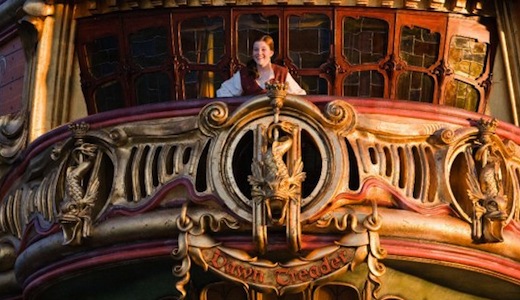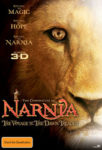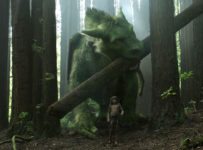C.S. Lewis’ Chronicles of Narnia, the collective name for the seven stories that make up his cycle of fantasy novels, have been adapted a number of times for the screen. First animated in 1979 for television by Bill Melendez (famous for the Peanuts cartoons), four of the stories were adapted for the BBC between 1988 and 1990, beginning with The Lion, The Witch and the Wardrobe and concluding with The Silver Chair, the fourth (by chronologically penultimate) novel in the series. The books remain children’s classics to this day, with the allegorical tales weaving cautionary messages and Christianity into the fantasy narrative. In 2005, Disney – in association with Walden Media – brought the stories to the cinema screen with a big-budget version of The Lion, The Witch and the Wardrobe, and it garnering modest critical respect and box office success thanks to its faithful rendering of the novel, and the wave of goodwill towards fantasy stories engendered by Peter Jackson’s Lord of the Rings Trilogy. Narnia sequel Prince Caspian, although another faithful adaptation, didn’t fare quite as well at the box office, and led to Disney and Walden Media reportedly parting ways over budgetary and “creative differences”. Luckily for fans, Fox picked up the ball that Disney dropped, and helped Walden push The Voyage of the Dawn Treader into cinema.
It has been a year since the events of Prince Caspian, and the eldest children Susan and Peter have travelled to America. Meanwhile, Edmund (Skandar Keynes) and Lucy (Georgie Henley) are forced to stay with their distasteful cousin Eustace (Will Pultner, Son of Rambow) during the closing days of the Second World War. Upon examining an odd painting of a ship in one of the children’s rooms, the trio are abruptly flooded and whisked off to the waters of Narnia. Rescued by Caspian (Ben Barnes, Dorian Gray) on his flagship The Dawn Treader, the group quickly becomes aware of a darkness growing across the land. Determined to find the source of this darkness, the group must travel to the furthest reaches of Narnia and face a series of mystical challenges along the way.
The Voyage of the Dawn Treader departs somewhat from the faithfulness to the novels of the first two entries, not only with director Michael Apted taking over directorial duties from Australia’s Andrew Adamson, but with the addition of a concocted conceit of a quest for seven swords to tie together the episodic nature of Lewis’ book. However, the writing of Lewis lends itself to this expansion: where J.R.R. Tolkien’s Lord of the Rings required reams of material to be trimmed for a screen adaptation, The Voyage of the Dawn Treader necessarily requires a bit of massaging to make a coherent film. The same was true of The Lion, the Witch and the Wardrobe, especially during the climactic battle sequences, although here the film is never fully separated from the feeling that things just keep happening purely for the purpose of something to do.
Eustace may also be one of the most annoying characters ever created for the screen, and his disbelief in all things Narnia – past the point that he has been teleported into a magical realm and spoken to a minotaur and a fencing mouse – defies logic and grates almost immediately. He seems to have one default pose of ‘flared nostril’, which is a real shame given his outstanding performance in the earlier Son of Rambow. Yet the worse crime is that The Voyage of the Dawn Treader never feels anything more than derivative, and has an ending that seems partly drawn from Ghostbusters – and an effects sequence that has stepped straight out of the 1980s as well.
What is most surprising is how much the Christian content has been cranked up for this outing. The Christian undertones have always been present in the works of C.S. Lewis, and the tale of the messianic Aslan the Lion’s execution and resurrection in the first film had clear roots in Christianity. Indeed, the children are referred to as the sons of Adam and the daughters of Eve in that film. However, here the Christianity is not so much an undercurrent as a blunt object in the hands of series screenwriters Christopher Markus, Stephen McFeely and Michael Pertroni. Through The Voyage of the Dawn Treader, the children are perpetually told that they must have faith if they are to continue, and each are tempted by ‘evil’ (and in the case of one child, physical transformation) in their path to finding Aslan. Before Aslan and the children part ways, he tells them that in the human world he has “another name. You must learn to know me by that name. This was the very reason why you were brought to Narnia, that knowing me here for a little, you may know me better there”. By way of comparison, many attribute the lack of The Golden Compass sequels to the anti-Church sentiment it displayed, so perhaps there is something of a method to Narnia’s madness after all.
It seems doubtful as to whether The Silver Chair will be made at this point, especially given that elements of that book were borrowed. While it seems a shame to stop telling the Narnia tales while we are halfway through the saga, given that Peter Jackson has had difficulties getting The Hobbit to see the light of day, a decreasingly profitable series of films is hardly likely to spark any green lights around Hollywood any time soon. The Voyage of the Dawn Treader is perhaps the most low-key of the films to date, and despite a few great set-piece sequences (including the unexpected transformation of a character into a dragon) and generally decent special effects, this latest installment just fails to wow the imagination to the same extent as the earlier entries.
The Chronicles of Narnia: The Voyage of the Dawn Treader is now playing at cinemas around the country, in both 3D and 2D versions of the film.






It may have been the lowest-key of the movies, but the book is similarly smaller in scope. I wasn’t too happy about the seven swords business, but the book reads like a series of disconnected events and that may not have worked in the movie, so tying it all together with the sword mcguffin may have been necessary.
You can’t pass it up if you have any feelings for “Narnia”, in book and/or movie form.
I too feel that there will be no more “Narnia” movies, which is an incredible shame, as I think the world needs these fantasy movies. It’s a similar fate to “Golden Compass”. Tremendous movie, that, but it seems that people don’t want to watch them. There’s something wrong with them in my opinion.